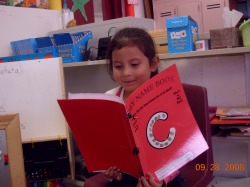Assessing Student Learning

My name begins with 'C'
5.1 Establishing and communicating learning goals for all students
5.2 Collecting & using multiple sources to assess student learning
5.3 Involving and guiding all students in assessing their own learning
5.4 Using the results of assessments to guide instruction
5.5 Communicating with students, families about student progress
5.2 Collecting & using multiple sources to assess student learning
5.3 Involving and guiding all students in assessing their own learning
5.4 Using the results of assessments to guide instruction
5.5 Communicating with students, families about student progress
Establishing and Communicating learning goals for all students
Learning goals for Kindergarten are comparable to what most first graders do in other schools. Each year the class is different. This year we have a large group and we have some younger students. We will scaffold reading in order to meet the needs of all students. Each reading group will have specific goals in each level. Students will be a part of setting those goals and will be rewarded at the end of the quarter with an event (activity, assembly, trip) if they have met their goals.
Assessment
Most assessment in kindergarten is oral and hands on. I meet with each student to see if they can perform and prove mastery with letters, words, numbers and other kindergarten standards. I use information gathered through formal and informal assessment to indicate if a student has learned the content and we can move on or if I need to provide further instruction, practice and reassessment.
Progress reports are sent out mid quarter and before report cards at the end of the quarter.
Communication

Let me show you why my name is important!
Parents receive a weekly newsletter that informs them of what their child will be learning. I regularly receive/send emails and telephone calls. I also have a website that is continually updated. It is linked with the school website and accessible through my faculty picture.
At parent teacher conference, all parents were given a list of tasks that their child will be required to know and do the next quarter.
At parent teacher conference, all parents were given a list of tasks that their child will be required to know and do the next quarter.
